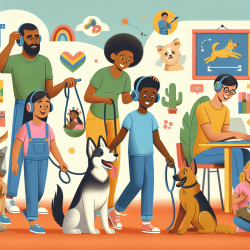As a passionate advocate for data-driven approaches in speech-language pathology, I'm excited to share insights from the systematic review titled "Animal-Assisted Interventions With Dogs in Special Education—A Systematic Review." This research provides valuable information on the impact of dog-assisted interventions on children with special educational needs. The review covers various functional domains such as stress reduction, motivation, social skills, cognitive abilities, reading abilities, social conduct, and mental wellbeing. Here, we'll explore key findings and practical applications for practitioners.
Understanding the Research
The systematic review analyzed 18 studies to evaluate the effectiveness of dog-assisted interventions in educational settings for children with special needs. While the studies varied in type, outcomes measured, and sample sizes, some clear trends emerged:
- Stress Reduction: The presence of dogs significantly lowered cortisol levels in children and pedagogues during stressful tasks, indicating a reduction in physiological stress.
- Motivation and Adherence: Dogs increased children's motivation to participate and adhere to instructions, enhancing engagement and learning experiences.
- Social Skills: Interventions involving dogs improved positive social behaviors and reduced negative behaviors in children with attachment and behavioral problems.
- Cognitive Abilities: Some studies showed improved performance in memory and categorization tasks when children worked with dogs.
Practical Applications for Practitioners
Implementing dog-assisted interventions can be beneficial in various ways. Here are some actionable steps for practitioners:
1. Incorporate Dogs in Stressful Situations
Use dogs during high-stress activities or assessments to help reduce anxiety and cortisol levels. For example, during speech therapy sessions, the presence of a dog can create a calming atmosphere, making children more receptive to learning.
2. Enhance Motivation and Engagement
Integrate dogs into learning activities to boost motivation. For instance, reading programs where children read aloud to dogs can increase their enthusiasm for reading and improve their reading skills over time.
3. Foster Social Skills
Dogs can act as social catalysts, encouraging positive interactions and reducing aggressive behaviors. Use dogs in group activities to improve social dynamics and help children develop better communication skills.
4. Support Cognitive Development
Incorporate dogs in tasks that require memory and categorization skills. The presence of a dog can make these tasks more engaging and improve children's performance.
Encouraging Further Research
While the review indicates promising results, it also highlights the need for more robust and long-term studies. Practitioners are encouraged to document and share their experiences with dog-assisted interventions to contribute to the growing body of evidence.
To read the original research paper, please follow this link: Animal-Assisted Interventions With Dogs in Special Education—A Systematic Review.










